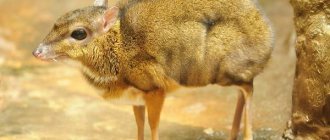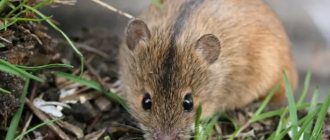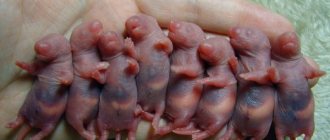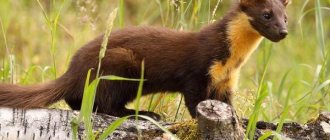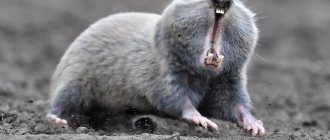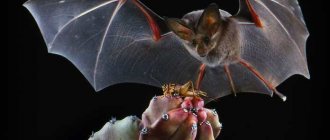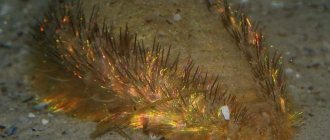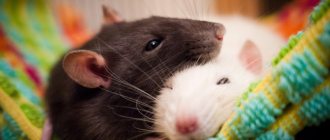Mice are small animals belonging to the class of mammals, an order of rodents from the mouse family.
They are found everywhere. The vast majority of their species live in tropical and subtropical forests, with fewer in the temperate and northern latitudes of Europe and Asia, as well as on the Australian mainland. There are approximately 13 species of mice common in the Russian Federation.
In total, the mouse family list includes 147 genera and 700 species. The size of the animal ranges from 5-48 cm, depending on the type of animal.
Below in the article we will try to describe what types of mice there are, how many species of them are found in Russia, what types of mice live where, and also provide their names, descriptions and photos.
Baby mice
They are one of the smallest rodents on earth. The size of an adult does not exceed 7 cm, the tail - 6-7 cm. The baby weighs no more than 10 g.
The appearance of the animal, namely its coloring, distinguishes it from other species. The fur of these mice is bright red in color, except for the abdomen, which is almost white.
Habitat: Spain, Korea, Japan, southern Kazakhstan, China and northern Mongolia. They are found in forests, fields and forest-steppe. In the summer they build nests in the grass, and in the winter they move into burrows, haystacks, and human dwellings.
Baby mice quickly adapt to their new environment. They are quite peaceful and calm. They can live in captivity. At the same time, the animals need a large, capacious cage or a small terrarium so that the little ones can move and climb freely.
In food, it prefers seeds, cereals, legumes, and small insects.
Types of mice with photos and names
The main description of the animal for all types: small weight and size. The color, ear shape and tail length are different. More than 300 species of mice have been recorded in the world. Two thirds of the list of varieties are common in warm countries such as Africa and Asia.
The breeds that people most often encounter, in addition to domestic ones:
- all varieties of voles;
- steppe and yellow variegation;
- mole vole;
- forest and field mice.
Depending on the climate, the types of domestic mice do not change, but wild ones are different. Thus, the little ones prefer to choose areas with warm winters, and voles are found in the Caucasus and Siberia.
Interesting fact! All types of mice constantly chew on something. The reason for this phenomenon is not hunger at all. The rodent has long teeth that grow 1–2 mm daily. For ease of movement and a comfortable existence, mice need to wear them down regularly.
Baby
The name says it all: a species of overly small rodent. The size of an adult reaches a maximum of 7 cm. The tail is equal to the length of the body. It belongs to the wild breeds, as it lives exclusively in nature. The nest is built from branches and grass. It moves well through trees thanks to its tenacious legs and sharp claws. The tail helps in moving along vertical surfaces.
Does not hibernate. Safely tolerates severe frosts. You can determine that a mouse is small in front of a person not only by its size:
- Color – red, as close to yellow as possible. Because of this feature, the baby is called a yellow mouse.
- The coat differs on the tips of the ears, belly and muzzle - dirty or yellow-white.
Habitat: England, Caucasus, Yakutia. It is a herbivorous species, but insects and worms are quite suitable as food. Farmers most often encounter this type of mouse, as the little one seriously damages garden crops, trees, and crops.
Wood mouse
Habitat: forest, densely planted plantings, mostly edges. Second name: wood mouse. Description of the species:
- color: dark red, brown, black;
- length: 8–10 cm;
- tail no more than 6–7 cm;
- A distinctive feature is large round ears.
Uses abandoned tree holes as a home. For wintering, it builds a deep burrow (up to 2–2.5 m deep) and stores huge reserves of food. The first emergence of a wood mouse indicates a long thaw.
It is not dangerous for humans, unless the forest zone borders on vegetable gardens and orchards. Capable of ruining the harvest in the field.
Gerbil
The rodent is native to the USA. It came to the territory of the post-Soviet space as an experimental creature. The appearance is very cute, even attractive. Therefore, this species quickly began to be considered decorative. Suitable as a pet. Keeping the animal is not difficult, and the food is simple: cereal sets, cheese, vegetables and fruits.
The gerbil does not have a specific mouse smell. The view is varied. There are up to 150 varieties. The most common were: Mongolian mouse and dwarf mouse.
Appearance:
- tummy – white;
- back with a bright black stripe;
- color: brown-red interspersed with black hairs;
- tail with a tassel;
- ears are round, small;
- nose: small pink;
- distinctive feature: large eyes.
Steppe mouse
A frequent enemy of farmers. In appearance, it resembles a gerbil, but does not have stripes on its back. Small: 5–7 cm in length. It differs from the mass of mouse species in the tail part, since it is 2 times larger than the body. Plus, he leads an active lifestyle during the cold season. Traces can be found wherever a rodent is looking for food. This often misleads ordinary people that it is not a mouse that lives in the marked place, but a rat.
It builds burrows closer to bodies of water with dense vegetation and bushes. In some reference books, the steppe mouse is classified as a species of vole.
House mouse
The house type of rodents is found in all parts of the globe, since they do not live outside. The main goal: to settle closer to humans for abundant nutrition. Color of the species: gray, almost earthen. In the warm season, it builds burrows close to housing, since food is available everywhere. But with the approach of cold weather, it quickly moves into apartments and houses.
He does not try to make reserves for the winter, since this is not necessary. Everything is suitable for food: furniture, grain, soap, clothes, interior items. Moves quickly. Able to settle down on the upper floors. Damages wiring and electrical wires. The house mouse thrives in cars where there are wires, upholstery, and non-metallic elements.
Description:
- ears: small, round;
- body: 6 cm;
- tail: 1–2 cm larger than the body.
The house mouse got its second name - gray-humped - because of its color. But in everyday life there are two types. They differ in color: gray and black. There are no other differences.
White mouse
The white long-eared rodent is not a specific species, but a genetic failure. The white breed is found in all forms. The color is uniform, can be diluted (rarely) with another color (gray, black, brown). Albinos most often have red eyes. Used for laboratory research. Such a representative is also purchased as a pet.
Important! Mice are carriers of numerous diseases, including those that are difficult to cure. If you purchased a rodent as a pet, then it remains one of the threats to infection. The risks of infection are reduced if the mouse is provided with proper care and the cage and housing are disinfected.
Ground mouse
Common name: ground rat or water vole. The rodent is similar in appearance to the second species, but larger in size (up to 25 cm). The tail and body are the same length, often the tail part is longer. Prefers marshy areas.
The coat is thick, including the tail. We can say that the animal is fluffy. Color: dark grey. They pose a threat to people in the form of damage to garden and field crops. When they meet, they try to quickly hide. It is not recommended to pick up or breed at home, since the earth mouse is a carrier of tularemia, Omsk and hemorrhagic fever.
Spiny mouse
A special type of rodent, as it combines the characteristics of several animals:
- capable of throwing off its tail like a lizard if life is in danger;
- physiology like mice;
- the presence of small needles in combination with wool.
It differs from mice in the gestation period: 42 days. There can be a maximum of 3 mice in a litter. Throughout the year, mating occurs only from the end of February until the onset of cold weather, which significantly reduces the population of the breed.
After the birth of the offspring, the mother takes care of the young for no more than 2 weeks. However, she does not go out hunting or for walks. Only after 14 days does the female begin to introduce the mice to the environment. This phenomenon is not characteristic of the mouse family.
Habitat: akomis or spiny mice are common in Western Asia, savannah. They live in burrows. They prefer to settle in rocky and sandy areas. Suitable for home breeding, as they do not have a mouse smell, like voles.
Need to know! You should not use homemade devices to catch mice. Especially if they involve current. Experts recommend using numerous humane options for eliminating rodents from a house, apartment or summer cottage.
Yellow-necked mouse
They inhabit the southern part of Russia. The species was noticed at the end of the 19th century. But in 2008 it was included in the Red Book. Despite its rapid reproduction, the species was exterminated very quickly. If it is difficult to notice a gray or black mouse right away, then the yellow-throated one is given away precisely by its color: bright red. Distinctive feature: large yellow stripe on the neck. Body length: 8–10 cm, large ears.
It chooses nuts, acorns, and beech (seeds) as food.
Rodents in general are pests of noble crops. But this is due to the need to feed the offspring. At the same time, mice are suitable as a pet, which, instead of causing harm, will delight children and adults with simple antics. Which species are suitable as a pet animal is clear thanks to the description and characteristics of the selected variety.
House mouse
The ability to get along with humans has made these animals the most common species of the mouse family and the most numerous of the mammals on earth. Distributed everywhere. The Far North, Antarctica, and highlands are places where these rodents are absent due to low temperatures and high humidity.
These mice are perhaps the smallest representatives of their family, if you do not take into account the tiny mice. The length of their body is no more than 10 cm, the tail is 5-10 cm. The animal has gray fur on its back, sides and a light belly. House mice that live in desert areas are sandy yellow in color, while domesticated house mice are white.
Unlike wild rodents, white decorative mice often become pets. In addition, they are bred in laboratory conditions as food for serpentarium pets, as well as for clinical studies as experimental animals.
In nature, rodents live in burrows. With the onset of autumn, they begin to move into residential buildings and outbuildings.
The main diet is seeds, grain, green parts of plants, and once in a person’s home, they sweep away everything that comes their way - from bread crumbs to soap and candles.
General characteristics of mouse representatives
The mouse family is diverse. Mice are omnivores and herbivores. Some were bred artificially so that they could be kept as pets. Habitat: all continents. The only place on the planet where mice are not found is Antarctica and mountain slopes.
Distinctive features of the appearance of mice are:
It is impossible to confuse mice with other rodents, since their size is too small. The color of the animal is varied, and only albinos have red eyes. The rest of the breeds have small black eyes.
All types of mice are fertile. Throughout the year, a sexually mature female brings up to 8–10 litters. But life expectancy does not exceed 5 years. Each litter contains from 5 to 8 mice. The duration of gestation is 21 days.
Young mice are born blind, without fur. Over the course of 14–21 days, the pups become similar to adults, but smaller in size. Completely independent, they get their own food.
Interesting fact! Reproduction activity occurs in the summer due to a sufficient amount of food. In autumn the animal is less active. In winter, the female is able to give birth only once.
Harvest mouse
Habitat: Central and Eastern Europe, the southern part of Western Siberia, China (except for the south), Mongolia, the Korean Peninsula, Taiwan. This type of rodent rarely lives in houses and outbuildings, unlike house mice.
The field mouse prefers open areas - bushes and fields. In megacities it mainly lives in green zones. Lives both in burrows and other natural shelters. Rodents that live in swampy areas build nests in bushes or grass.
The body length of the animal can reach up to 12.5 cm, the tail – up to 9 cm. The color of the field mouse is grayish-brown, with a dark stripe running along the back.
The animal’s diet, which changes depending on temporary conditions, is based on plant foods and insects. Field mice are the largest pests for agriculture and forestry, and they can also live in country houses.
Diversity of the mouse family
Types of mice Animals are best adapted to any living conditions. Agile, agile in their movements, rodents can run quickly, jump, climb, penetrate through the narrowest holes, and if there is an obstacle in front of them, then sharp teeth are used. A description of a mouse would not be complete without mentioning that they are quite smart and cautious, but at the same time shameless, cunning and brave. Possessing an excellent sense of smell and hearing, they are able to quickly respond to danger.
Wood mouse
The animal prefers natural shelters, its own or others' burrows in floodplains, in thickets of meadow bushes, and in open areas of forest. Their habitats are broad-leaved and mixed forests of Eastern Europe, Turkey, the Caucasus, Kazakhstan, Altai.
It reaches 10 cm in size. The length of the tail is approximately the same as the length of the body. Color – grayish-red. Some individuals have a yellow spot in the chest area.
Rodents, as a rule, feed on plant foods (grain, seeds), and do not refuse insects. They eat young tree seedlings, causing severe damage to forestry.
What are the external features of the mouse?
Nowadays, many photos of mice are taken, and they are easy to find on the Internet. Due to this, it is possible to accurately determine what species a mouse that appears on human territory belongs to.
Usually its body does not exceed 10 cm, moreover, about half the size is the tail. This small process is always bare, and it is difficult to detect the presence of hairs on it. At the same time, the body is completely covered with hair of a uniform color.
However, there are two unique species that have spines that replace fur. We are talking about Elliott the mouse and the so-called spiny species. The fur of these strange creatures is replaced by needles similar to thorns, like those of a cactus.Mice are brown, sometimes brown, and gray ones are common. Scientists have discovered mice that have stripes running down their backs.
Vole mouse
Distinctive features of this type of rodent are their short tail, small ears and small muzzle. The length of the mouse's body, not including the tail, is 12 cm. The color is gray or dark brown, the abdomen is gray.
Habitat: North Africa, Middle East, northern India, southwestern China, Taiwan, Japanese Islands, North America.
Like a mole, the vole digs deep, multi-pass burrows. The animals are active at night and are underground during the day. They feed on plant foods - green parts of plants, roots, tubers.
You can try to fight small rodents using ultrasound.
Reproduction and lifespan
Mice mating occurs without long and lengthy foreplay. As a rule, the male smells the female, finds her and mates. After some time, the female brings from 3 to 10 mice. Mice are born blind and naked, but they develop too quickly. Already at 30 days, the small female becomes sexually mature, and the male reaches sexual maturity at 45 days.
This is easily explained by the fact that the life of this rodent is not long at all, only 2-3 years. But, since a female can bear offspring 3-4 times a year, the population is restored in abundance.
General characteristics
A mouse is a small mammal with an elongated body, a pointed muzzle, and large oval ears.
The size of the animal can vary from five to twenty centimeters, the body length depends on the species; large artificial breeds are called decorative breeds.
A distinctive feature of mice is their long flexible tail, which has no hair or is covered with sparse, coarse hair.
The characteristic features of the appearance and structure of mice are called:
- Vision. Animals living in the wild have acute vision, which allows them to see danger even at a great distance. Mice do not perceive blue or green colors, but they distinguish between red and yellow shades. Artificially bred mice with white or other colors have relatively low vision, which is due to the absence of possible risks and external enemies.
- Dental system. A rodent's incisors do not have roots and continue to grow rapidly throughout its life, the average growth rate being from half to one millimeter per day. To prevent excessive growth of the incisors, mice are forced to constantly grind them down.
- Lifestyle. Rodents are characterized by mobility, which is due to the need to maintain a constant body temperature. Active movements help animals not to freeze in the cold season and prevent the body from overheating in the hot summer.
Mice living in the wild store food during the famine cycle, which allows them to avoid starvation.
But if the animals live close to human habitation and have constant access to food sources, there is no need to create pantries.
Where does the mouse live?
Mice live in all corners of the planet, with exceptions including northern and high mountain regions.
At the same time, some species live in hot, dry climates, others prefer areas of high humidity, and still others live in countries with temperate conditions.
Separately, it is necessary to consider synanthropic species of mice, which include field mice and house mice. These rodents are capable of living in the wild, but prefer to settle close to human habitation, which provides them with access to food sources all year round.
How do they behave and where do they live in their natural environment?
The life of mice is a constant bustle, searching for food and eating it. Habits are related to the fact that animals need to maintain body temperature. In addition, rodents have to be constantly on guard to avoid becoming prey to predators. The lifestyle depends on the species - some mice are active during the day, others at night.
Most often, mice live in large colonies. Each pack has a leader who controls the others. Sometimes conflicts and struggles for power arise. Such collisions can cause the disintegration of a mouse family.
Mice live in burrows that they dig underground. Most often, a hole consists of 1-2 nests connected by passages, several storage rooms and exits to the surface.
